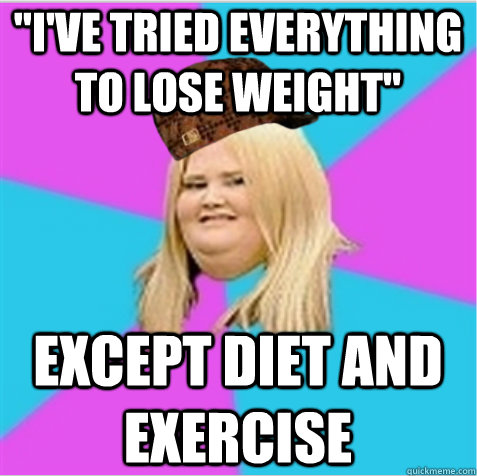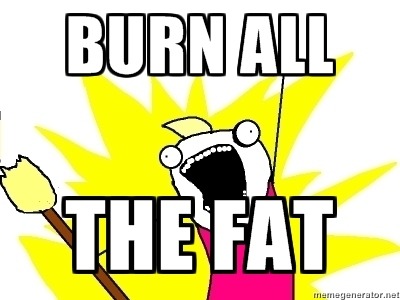As 2013 ends, and 2014 comes full steam ahead, many of us
begin making New Year’s Resolutions. Many of those New Year’s Resolutions begin
with improving our health. Some of us say “This year I’ll eat healthier,” or
“This year I’m going to start going to the gym.” While these are great goals,
they’re not nearly specific enough. I implore you to make specific long term
goals, along the lines of “This year I’m going to lose 15 pounds of fat, while
keeping my lean body mass the same.” Now that’s a goal!
Weight loss is often a goal that many of us strive to
achieve, and often times we become obsessed with the scale. And numbers. To me,
this is a very flawed approach that doesn’t necessarily lead to a healthier
you. When you diet and lose weight, your body will use stored energy (Usually
fat, sometimes muscle) as fuel to meet the energy needs your body is under. As
you lose weight, you can just become a smaller version of the same unhealthy
person before. Your fat loss may decrease, but so will your lean body mass. In
this article, I’m going to show you how and why you should track your body fat
percentage with your weekly weigh-ins to determine if your diet is healthy and
helping you, or just making a smaller version of your previous overweight self.
I’ll also share some tricks to help break through fat loss plateaus and how
taking one step backwards can lead to two steps forward.
Calculating Fat Mass
To calculate your fat mass, and determine your Lean Body
Mass, you need to find out your body fat percentage. To find your BF %, there
are websites online that can help estimate your body fat from getting
circumference measurements. You can also have a personal trainer use skin fold
calipers to help determine your fat mass. A third way is to purchase a hand
held device, which surprisingly can work very well if you know how to do it
right. Googling these types of devices can help you figure out how to use them
optimally, and how they work.
When you cut calories to very low levels, your body will
mobilize and oxidize what it has stored and you begin to lose weight. But you
should focus more on fat loss, not weight loss, which is why the scale can be
deceiving. For example let’s look at two guys, both 30 years old, 5’9”,
250-pounds, and both have 35% body fat (TDEE of 2,400 for the example)
According to their stats listed above, each guy has
87.5-pounds (Total Weight x BF %) of fat mass on them. Their Lean Body Mass, or
LBM, is 162.5-pounds (Total Weight – Fat Mass). Lean body mass makes up muscle,
organs, bones, skin, and other tissue that is vital to our survival.
Example A - Dave
Dave cuts his maintenance calories by 1,200 calories per
day. He’s extremely happy how he’s cut weight. Yeah he’s hungry, but he doesn’t
care he’s dropping weight like crazy and even has gotten a couple of
compliments from his friends and family. As he looks at the scale 4 weeks
later, he’s lost 60 pounds. But, after calculating his body fat %, it’s only
dropped to 31%. So his fat mass has decreased to 58.9 lbs, but his LBM has
decreased to 131.1 lbs. That’s a 30-pound drop in LBM and about 53% of the
weight lost! So while he’s lost sixty pounds, more than half of that was lean
body mass. No bueno. Dave’s fat loss begins to stall, throws in an hour of
cardio a day, and still no more weight loss. His recent blood work shows no
real crazy improvement in cholesterol levels or triglycerides, even though he’s
lost 60 pounds. He’s also beginning to feel weak, tired, and hungry all the
time.
Example B – Tom
Tom takes a more patient approach to his lifestyle diet, and
begins to cut his calories at a 500-calorie deficit and begins to incorporate
weight training and cardio 4 times per week. After 4 weeks, Tom’s lost 30
pounds, but his BF % has decreased from 35% to 27%. So now, Tom’s fat mass is
59.4-pounds, and his LBM is 160.6. While Tom has lost half the weight as Dave
did, Tom has lost only 1.9-pounds of LBM, and has lost 28.1-pounds of fat mass!
94% of the weight Tom lost has been pure, blubbery fat. Tom feels the best he’s
ever felt, and his fat loss is continuing. He’s getting stronger in the gym,
and his recent blood work has shown improvement in all major blood readings. He
feels motivated and keeps plugging along aiming to lose about a percent or two
of body fat per week.
Why You Should Follow
Tom and Not Dave
Obviously, the extreme drop in LBM for Dave is very
concerning. LBM is vital in our lives. Also, LBM is more metabolically active in
the body. While fat doesn’t require any energy to maintain, LBM eats up
calories while you’re at rest, effectively allowing you to burn more calories
even while you sit and read this article! That’s why those who gain muscle
weight need to eat more to maintain that muscle. Muscle, and LBM eats up more
calories.
How to Retain LBM,
and Drop Fat Mass
Consuming Less
For starters, the law of weight loss states that in order to
lose weight, fewer calories must be consumed than what you expend. So first
lets look at the consuming fewer calories side of the equation. Taking a
drastic cut in calories is a sure shot way to lose LBM. Those who are much
heavier can get away with bigger caloric deficits, but if you’re smaller and
leaner a smaller caloric deficit should be used. A good way to determine a good
starting point is to subtract your TDEE by about 15%. This is a good decrease
to start with and will result in a loss in weight.
A lot of websites and calculators will recommend an initial
drop of 20%, but it’s better to start with a smaller caloric deficit. By
starting with a smaller caloric deficit, you can further reduce calories as you
hit fat loss plateaus. Your body will adapt as you get smaller and lose weight,
needing less calories. When you stop losing weight, another drop in calories
can break your plateau, and since you started with a smaller deficit to begin
with, you won’t go into a starvation diet or want to go crazy from a lack of
food.
Expending More
The other side of the equation is expending more energy.
While many associate fat loss to cardio, I’m going to tell you why weight and
strength training is more important in an overall healthier body. Weight
training, like cardio, expends a large amount of calories. Intense weight
training sessions can have you burning more calories hours after exercise as
your body and metabolism try to adapt to the stressors you placed on it. Weight
training will also help you retain muscle and LBM, and for beginners, you can
even see reductions in fat mass while seeing increases in LBM/muscle! Weight
training can also reduce bone density losses in the elderly. It can also reduce
the risk of losing muscle mass, also known as sarcopenia, which can leave you
weak and frail. Losing weight is great and all, but weight training will give
you more muscle to give you a better look.
Cardio has its place, but diet and weight training is the
key to having a better body composition. When fat loss stalls after your
caloric deficit and weight training is in effect, add more cardio. From the
beginning I would recommend 2-3 cardio sessions of lower intensity per week.
They can last about 30 minutes and should be mainly used to help improve heart
conditioning. As you hit a plateau, and you will hit plateaus, you can increase
cardio. Plateaus are normal, and it’s your body’s way of adapting. Increases of
cardio can include increased intensity, time, different methods (Treadmill
instead of bike), or even decreased rest intervals during your resistance
training workouts.
Diet Breaks and
Refeeds
As the time wears on and you continue to slowly lose your
fat mass, retain LBM, and increase your strength, you may find yourself getting
tired and groggy all the time. As you continue to diet and remain in a caloric
deficit, your body will begin to feel fatigued from all the stressors placed on
it. This is where a diet break or a refeed can be used to re-stimulate the
metabolism, and give you that psychological break from dieting as well.
A diet break is usually a one-week break an individual will
take from dieting. While food choices still matter, the quantity will increase
from the high quality foods you’re already consuming. I recommend raising your
caloric intake back to maintenance levels, let your hormones get back in check,
and your metabolism gets another boost. After a week you’ll have much more
energy, and you can return to your caloric deficit and get back on the fat loss
train.
A refeed is when you take a whole day, or meal, and increase
your calories to help restore hormonal balance and boost your metabolism. As
physique athletes get extremely lean, they tend to include refeed days once or
twice a week. In general, once every 7-14 days seems to be enough. Whether your
refeed day is a “cheat” day or just an increase in calories, it’s very
important that the caloric increase mainly comes from carbohydrates. As you get
leaner and leaner, the hormone leptin begins to fall. Leptin helps control
cravings and energy expenditure. As you diet for long periods of time or to
extremely lean levels, your body will sense it’s “starving.” It decreases
leptin to help slow down the dieting process and retain its homeostasis (Very
brief explanation on leptin, it’s much more complex than this).
So how do we raise leptin? While a cheat meal may seem like
a perfect chance to indulge yourself, it can be counterintuitive as many of us
can go to an all you can eat buffet and crush 6,000 calories without even
knowing it. It’s best to stay within choosing quality food choices, but the
occasional “cheat” is okay. It’s been seen that total day refeeds are more
effective at stimulating the metabolism and raising leptin and other hormones
that decrease with dieting. Carbohydrates also seem to have the greatest effect
on leptin restoration. I would recommend protein and fat 25% and 15% of total
calories respectively, and carbohydrate consumption taking up 60% of your
calories. People usually place their most strenuous workouts, or lagging body
parts, on the day of their refeeds as well, as refeeding puts you in a very
anabolic state.
Hopefully after reading this article, you’ll further
understand why losing fat mass, and not total weight is more important. Keep
that LBM and muscle to have a more healthy body! If you’re one of those people
who are ready to lose weight during the New Year, good luck! Consistency is
key, and just keep plugging along. Don’t get discouraged from plateaus: Expect
them, and use the tools listed above to break right through them.


No comments:
Post a Comment